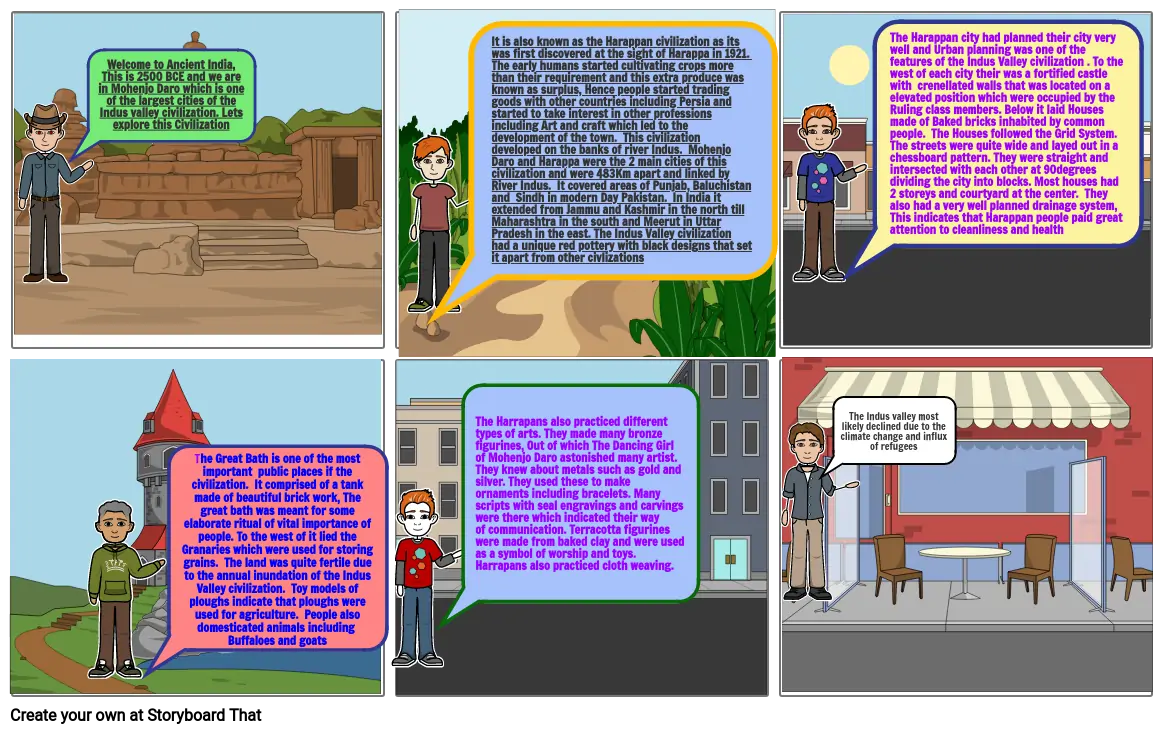Gourishankar 6M SSt- Indus Valley Civilization Storyboard MA1

Texto del Guión Gráfico
- Welcome to Ancient India, This is 2500 BCE and we are in Mohenjo Daro which is one of the largest cities of the Indus valley civilization. Lets explore this Civilization
- It is also known as the Harappan civilization as its was first discovered at the sight of Harappa in 1921. The early humans started cultivating crops more than their requirement and this extra produce was known as surplus, Hence people started trading goods with other countries including Persia and started to take interest in other professions including Art and craft which led to the development of the town. This civilization developed on the banks of river Indus. Mohenjo Daro and Harappa were the 2 main cities of this civilization and were 483Km apart and linked by River Indus. It covered areas of Punjab, Baluchistan and Sindh in modern Day Pakistan. In India it extended from Jammu and Kashmir in the north till Maharashtra in the south and Meerut in Uttar Pradesh in the east. The Indus Valley civilization had a unique red pottery with black designs that set it apart from other civlizations
- The Harappan city had planned their city very well and Urban planning was one of the features of the Indus Valley civilization . To the west of each city their was a fortified castle with crenellated walls that was located on a elevated position which were occupied by the Ruling class members. Below it laid Houses made of Baked bricks inhabited by common people. The Houses followed the Grid System. The streets were quite wide and layed out in a chessboard pattern. They were straight and intersected with each other at 90degrees dividing the city into blocks. Most houses had 2 storeys and courtyard at the center. They also had a very well planned drainage system, This indicates that Harappan people paid great attention to cleanliness and health
- The Great Bath is one of the most important public places if the civilization. It comprised of a tank made of beautiful brick work, The great bath was meant for some elaborate ritual of vital importance of people. To the west of it lied the Granaries which were used for storing grains. The land was quite fertile due to the annual inundation of the Indus Valley civilization. Toy models of ploughs indicate that ploughs were used for agriculture. People also domesticated animals including Buffaloes and goats
- The Harrapans also practiced different types of arts. They made many bronze figurines, Out of which The Dancing Girl of Mohenjo Daro astonished many artist. They knew about metals such as gold and silver. They used these to make ornaments including bracelets. Many scripts with seal engravings and carvings were there which indicated their way of communication. Terracotta figurines were made from baked clay and were used as a symbol of worship and toys. Harrapans also practiced cloth weaving.
- The Indus valley most likely declined due to the climate change and influx of refugees
Más de 30 millones de guiones gráficos creados

